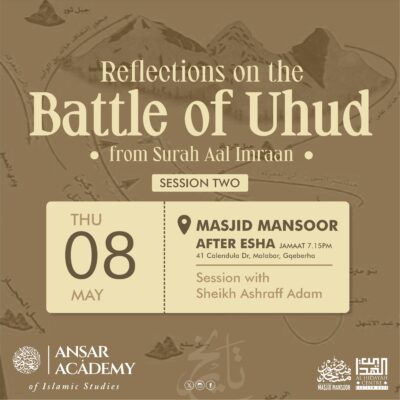The North African country of Libya has been in the news of late due to the catastrophic floods of September 2023. Over three thousand people are confirmed to have lost their lives while many thousands more are missing. The city of Derna was especially hard-hit with a quarter of the city being wiped out. The storm that caused the catastrophe is estimated to be the deadliest to hit Africa in recorded history.
A Beautiful Country
The Danish Muslim convert to Islam, Knud Holmboe (who took the name Ali Ahmed el Gheseiri) journeyed across the Sahara from Morocco to Libya in 1930. He came from an affluent family and accepted Islam in 1925. He travelled widely and is well known for exposing the European colonial atrocities against the civilian populations especially in Muslim North Africa. He also witnessed the Italian mistreatment in Albania. In Libya he wrote extensively about the crimes of the Italian occupation forces against the Muslims and took photographic evidence. He was arrested by the Italians in Libya and thrown out of the country while on his trip from Morocco to Egypt.
He wrote a book called Desert Encounter condemning the colonial regimes in North Africa and especially the Italian terrorism and genocide against the Muslims in Libya. He started for Hajj in 1931 after writing the book but was murdered in Aqaba with many suspecting Italian intelligence having conspired in his death.
He made it as far as Derna in Libya on his trip and describes the city:
“As far as climate goes, Derna is Paradise on earth. It is situated by the shimmering blue Mediterranean and has the most marvellous temperature in all Africa. All Derna is a sea of flowers, and all the world’s most wonderful fruits grow here. Derna has the clearest, sweetest, and purest water in North Africa. It comes down from the mountains and flows over the ground in the town itself and its environs. The ground in Derna is covered with a thick carpet of grass where gaily coloured flowers grow. In the gardens the fan-shaped banana trees bear their yellow burdens the whole year round, and even if the bananas are not as big as the famous fruit from Jamaica their flavour is much better, like a mixture of pineapple and strawberry. Apricots and peaches grow as big as goose-eggs and the blue and green grapes which twine on the frames across all the streets, and which in the autumn are bursting with the pressure of the juice, are large and heavy as pigeon’s eggs. And just as the town itself is bright and kindly, lying there under the perpetually blue sky, so are its people too. There are few places in North Africa where Islam is followed more scrupulously than here.”
Unfortunately, at that time the Italian occupiers were carrying out a genocide against the people of Libya and the last chapters of Holmboe’s book are one of the very few records of these crimes against humanity. It brought to light the violent grip of Mussolini’s Italians in Libya. During his stay in Cyrenaica, the eastern region of the country, he wrote, “Thirty executions took place daily, which means that about twelve thousand Arabs were executed yearly, not counting those killed in the war.” Bedouins also saw their wells cemented useless by the Italian military and livestock mowed down by machine gun fire, which forced the desert-dwellers to choose either slow death or humiliation in dilapidated concentration camps. “The land swam in blood,” Holmboe wrote.
Long, Rich History
Libya has a long and rich history. It is the fourth largest country in Africa and the 16th-largest in the world. The overwhelming majority of the people are Muslim, and the country has stayed firm on Islam since the early days of Islam.
The Phoenicians were the first to establish trading posts in Libya. By the 5th century BC, the Phoenician colony Carthage had extended its rule across much of North Africa including Libya.
In 630 BC, the Greeks colonized the area around Barca in Eastern Libya and founded the city of Cyrene. Within 200 years, four more Greek cities were established in the area that became known as Cyrenaica. In 525 BC the Persian army of Cambyses II overran Cyrenaica, which for the next two centuries remained under Persian or Egyptian rule. Alexander the Greek ended Persian rule in 331 BC. Eastern Libya again fell under the control of the Greeks.
Rome formally annexed the Libyan region of Tripolitania in 74 BC and joined it to Crete as a Roman province. As part of the Africa Nova province, Roman Tripolitania was prosperous, and reached a golden age in the 2nd and 3rd centuries. On the Eastern side, Cyrenaica’s first Christian communities were established by the time of the emperor Claudius. Libya was also until recent times the home of one of the oldest Jewish communities in the world, dating back to at least 300 BC. A series of pogroms by the Italians 1945-1948 drastically reduced Libya’s Jewish population.
Under the command of the Sahabi Amr ibn al Aas radhiallahu anhu, the Muslim army conquered Cyrenaica. In 647 an army led by Abdullah ibn Saad took Tripoli from the Byzantine Romans. Fezzan was conquered by Uqba ibn Nafi in 663 and the Berber tribes accepted Islam. For the next several decades, Libya was under the rule of the Umayyads until the Abbasids overthrew them in 750, and Libya came under Abbasid rule. Admiral Sinan Pasha took control of Libya for the Ottomans in 1551 from the Knights of St. John. Libya remained under Ottoman control until the Italo-Turkish War (1911–1912) when Italy occupied the country.
Colonial Atrocities
The Libyan region of Tripolitania was the scene of the first war of imperialism waged by the USA outside the American continent. In 1801 US President Thomas Jefferson ordered a naval and military expedition to North Africa in what became known as the Barbary War. The Pasha of Tripoli declared war on the USA. In 1805 US forces stormed the harbour fortress of Derna. This event marks the birth of the US Navy and Marines and is commemorated in the Marine’s battle hymn.
In 1911, Italy went to war with the Ottoman Empire and invaded Ottoman Tripolitania. One of the most notorious incidents during this conflict was the October Tripoli massacre in 1911 when the Italian military attacked the population of the Mechiya oasis, massacring 4,000 people including women and children over the course of three days. The civilians were murdered in the streets, in their houses, farms, gardens, and in a mosque, where several hundred women and children had taken refuge.
In 1912, 10,000 Turkish and Arab troops were imprisoned in concentration camps in Libya. All Turkish troops were executed.
Knud Holmboe described the concentration camps into which the Italians forced the Muslim population where torture and famine were rife. The so-called “pacification of Libya” by the Italians resulted in mass deaths of the people in Cyrenaica, killing approximately one quarter of the population of 225,000. In 1923, Italian leader Mussolini embarked upon a brutal campaign to break the Libyan liberation movement. Italian forces began to occupy large areas of Libya to allow Italian colonists to rapidly settle in it. Civilians were executed. Refugees from the fighting were subject to bombing and strafing by Italian aircraft. In 1930, in northern Cyrenaica, 20,000 Bedouin were relocated, and their land was given to Italian settlers. The Bedouin were forced to march across the desert into concentration camps. Starvation and other poor conditions in the camps were rampant and the internees were used for forced labour, ultimately leading to the death of nearly 4,000 internees by the time they were closed in September 1933.
Ilan Pappé estimates that between 1928 and 1932 the Italian military killed half the Bedouin population directly or through disease and starvation in concentration camps in Libya. During that era, Italy’s policy of unleashing unmitigated violence to destroy the Libyan resistance and subdue the local population would result in the death of more than 83,000 Libyans. Around 70,000 mostly civilians including women, children and the elderly, died of starvation and disease.
The German Nazis copied the extreme violence carried out by the Italians against Libyans and it became a model for what they would end up doing on European soil. Their field visits to Libya were followed by books, conferences, and seminars on the Italian colonial experience both in Libya and Abyssinia (Ethiopia), where the Italians carried out a similar campaign of extreme violence.
Heroic Resistance
It was during this period that the Muslims of Libya put up some of the most heroic resistance to occupation. Omar al Mukhṭar Muḥammad bin Farḥaṭ al Manifi rahimahullah (b. 1858 – d. 1931), called The Lion of the Desert, was an Imam and leader of Muslim resistance in Cyrenaica (Eastern Libya) under the Senussids, against the Italian colonization. A teacher-turned-general, Omar was a prominent figure of the Senussi movement. Beginning in 1911, he organised and led the Libyan resistance movement against the Italian colonial empire during the First and Second Italo-Senussi Wars. Externally, he also fought against the French colonization of Chad and the British occupation of Egypt. After many attempts, the Italians managed to capture him near Slonta when he was wounded in battle and hanged him in 1931 at the age of 73 after he refused to surrender.
Knud Holmboe wrote of the regal bearing with which the captured Muslim fighters faced execution. “Nothing in their faces showed terror of death.” Omar al Mukhtar rahimahullah also faced his martyrdom with great nobility reciting the verse of the Noble Quran, “From Allah we come and to Allah we must return.”
Another prominent resistance leader, Idris al-Mahdi as-Senussi (later King Idris I), Emir of Cyrenaica, continued to lead the Libyan resistance until the outbreak of the Second World War. Libya became independent as a kingdom in 1951. A military coup in 1969 by Muammar Gaddafi overthrew King Idris I and created a republic. Civil wars followed Gaddafi’s overthrow in 2011 with Libya currently split in two regions. The country has the 10th-largest proven oil reserves in the world.
Libya has been the scene of events of great significance. It has held firmly to Islam through all the tests and saw some of the greatest resistance to colonialism anywhere.








COMMENTS